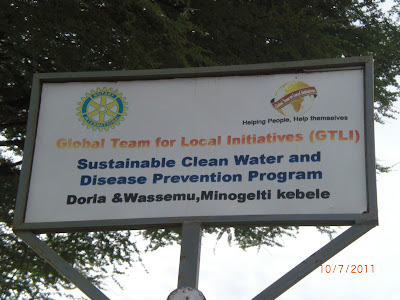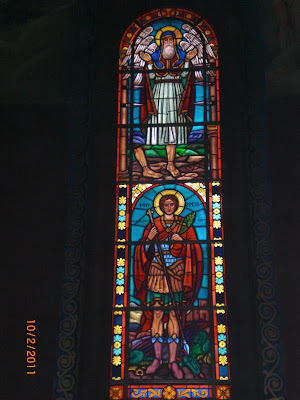Global Team for Local Initiatives (GTLI)
Rotarians Mike, Lori Pappas (GTLI) and Yemani
A beautiful Hamar woman and her baby in school.
I had a once in a lifetime opportunity to accompany 3 local Rotarians from the Addis Ababa West Club to evaluate some Rotary projects in South Ethiopia near the Kenya border. Rotarian Lori Pappas of “Global Team Local Initiatives” has been living and working among the Hamar Tribe for the last 4 years bringing them water, sanitation and education. Her personal sacrifices and love for these people moved me greatly. We were so impressed with her projects and the progress she is making here.Hamar girls waiting to fill their water containers.
Global Team for Local Initiatives has built a school and many come to learn everyday.
It’s hard to put into words what I saw and experienced, but I will try. First, getting there is two full days of driving on bumpy roads. It was an exhausting, adventurous and the scenery was breath taking. Yemani had the difficult task of driving us far into the wilderness and he took us on several detours. Sometimes we were lost; roads aren’t often marked. Mike and Askale and I made four in the car. The cover of their workbooks have OBAMA on them!!
These young women are so happy to be learning and improving their lives.
It seemed like I stepped into a National Geographic film when we arrived at the GTLI camp. Time forgot the Hamar tribe. The area is experiencing the worst drought in history and the people are suffering. Many, especially the elder ones, are mere skin and bones. My heart ached. Only two months of sorghum grain can be grown, so the rest of the year, they go hungry. They are slowly eating their only assets, cattle and goats. Even the livestock were thin and under nourished. What will happen to them when the livestock is gone? The elderly and children are the first victims of the worst drought in history.
The women wore goat skins and were mostly uncovered. They were adorned in their traditional beads, shells and feathers. They wear metal bracelets around their wrists and forearms and when they dance, they rub their arms together to make music. A certain necklace signifies whether they are the first wife or second wife. They almost all have many scars on their backs; some were even scarred in a decorative fashion. They use red clay and butter to form beautiful dreadlocks in their hair. Their bodies glisten with the red clay and butter mixture, and their skin is healthy and shiny from it. Their teeth are straight and white. I had entered their world for a day.
Her husband, a warrior, has scarred (decorated) her back llike this.
She took these strikes to show her love for a male member of her family during the Bull Jump Ceremony.
Some of the men wore western T shirts and shorts, but many were still dressed traditionally; a short wrap around skirt, a head wrap and beads. Every man carried his portable seat/neck rest. The children were mostly running around naked. Many of their bellies were swollen with worms. In general, people were very thin. A cow was killed for our dinner and celebration. It was quite gruesome. They drink the cow's blood, stick their head in its stomach to inhale the fumes, rub bile on their legs, and spear the meat to cook by the fire.
Hamar man butchering a cow. Every part of the cow is eaten or used. Nothing is wasted.
Tending the fire
When a young man in the family decides it is time to become a man, he must ‘jump the bulls”. Before the trip, I googled “Hamar Tribe, Ethiopia” and saw the ceremony on you tube. As part of the ceremony, the women in his family are whipped. Being whipped and scarred shows their love for him. In the future, he will return this favor by protecting and caring for the women in his family. One whole cow cooking by the fire.
This Hamar man made by wooden seat/neck rest.
So what is Lori doing living among this tribe and sacrificing so much of her life, time, money, love, and health for? I will only be scratching the surface. She has brought life sustaining water to the area. She has taught them how to dig latrines away from the water source. She is educating them and teaching them sustainable vocations; chicken farming (eggs), gardening, goat skin tanning, and jewelry making. She is teaching them to use more caution when applying the salve on the bleeding backs of the girls from one pot because if even one girl is HIV+, the entire females of one family could be wiped out. She is teaching the girls to cut their bangs a bit higher so that the clay and butter doesn’t drip into and infect their eyes. The list just goes on and on.Water wells and latrines are both important projects for Lori and GTLI.
I actually used this pit latrine!
Now Lori needs the funds to bring a health center to the area. They need access to antibiotics so that a small cut doesn’t become life threatening. The children need de worming pills. Women need access to care if childbirth becomes difficult. This need doesn’t exist now. Lori with the leader of the local Hamar Tribe.
Askale, Yemani, Lori, Michael, GTLI staff, and I on our last morning.
Lake Chamo near Arba Minch
The arrival of the Hamar women to greet us.
I have been blessed this year to visit three of the Seven Wonders of the World; the Great Wall of China, Machu Picchu and Taj Mahal. I would like to add Hamar Tribe, Ethiopia to that list. It is truly a forgotten “wonder of the world”. My life has once again been forever changed. 


































